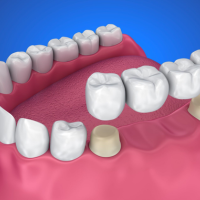
Table of Contents
ToggleCrowns and Bridges:
Crowns and bridges are common dental restorations that help restore the function, shape, and appearance of damaged or missing teeth. They play a crucial role in modern dentistry, offering solutions for those dealing with tooth decay, injury, or tooth loss. In this article, we’ll explore what crowns and bridges are, their benefits, the procedure involved, and how to care for them.
What Are Crowns?
A dental crown, often referred to as a cap, is a tooth-shaped cover placed over a damaged or weakened tooth. It helps restore the tooth’s strength, size, shape, and appearance. Crowns can be made from various materials, including:
- Porcelain or Ceramic: These materials are popular for their natural appearance and are often used for front teeth, as they closely match the color of natural teeth.
- Metal Alloys: These are highly durable and often used for molars, where strength is critical.
- Porcelain-fused-to-metal: Combines the strength of metal with the aesthetic appeal of porcelain.
- Resin: These crowns are less expensive but wear down over time.
When Are Crowns Needed?
Crowns are typically recommended in the following cases:
- To protect a weakened tooth: Often after a large cavity or root canal, crowns protect teeth from further damage.
- To restore a broken tooth: If a tooth is cracked or severely worn down, a crown can restore its function.
- To cover a dental implant: Crowns are used to cover implants when replacing a missing tooth.
- For cosmetic reasons: Crowns can improve the appearance of discolored or poorly shaped teeth.
What Are Bridges?
A dental bridge is used to replace one or more missing teeth. The bridge consists of artificial teeth, called pontics, that are anchored by crowns placed on the adjacent natural teeth or dental implants. These natural teeth, or implants, are referred to as abutments.
Bridges help restore the function and appearance of teeth, preventing the shifting of surrounding teeth and maintaining facial structure.
Types of Bridges
- Traditional Bridge: The most common type, where crowns are placed on the teeth adjacent to the missing tooth or teeth, and the pontic is secured in between.
- Cantilever Bridge: Used when there’s only one adjacent tooth next to the gap.
- Maryland Bridge: This type uses a metal or porcelain framework to bond the pontic to the back of the adjacent teeth. It requires less alteration of the neighboring teeth.
- Implant-Supported Bridge: Implants are placed directly into the jawbone, and the bridge is then secured to these implants. This type is ideal for cases where multiple teeth are missing.
Benefits of Crowns and Bridges
Both crowns and bridges offer a range of benefits, including:
- Improved Functionality: By restoring damaged or missing teeth, crowns and bridges help you chew and speak properly.
- Enhanced Appearance: Crowns and bridges improve the appearance of your smile, as they are designed to match the shape and color of your natural teeth.
- Long-Lasting Solution: With proper care, crowns and bridges can last many years, making them a durable solution for dental restoration.
- Prevention of Further Dental Problems: Bridges prevent the remaining teeth from shifting into the gap left by missing teeth, which can lead to bite problems and jaw pain. Crowns protect weakened teeth from further damage.
The Procedure for Crowns and Bridges
For Crowns:
- Preparation: The dentist numbs the tooth and removes any decay or damaged portions. The tooth is then shaped to fit the crown.
- Impression: An impression of the tooth is taken to create a custom-made crown that matches the natural tooth.
- Temporary Crown: While waiting for the permanent crown, a temporary one is placed over the tooth to protect it.
- Permanent Crown Placement: After the crown is fabricated, it’s cemented onto the prepared tooth.
For Bridges:
- Preparation of Abutment Teeth: The adjacent teeth are shaped so they can support the crowns that anchor the bridge.
- Impression: An impression is taken of the prepared teeth and gap to create a custom bridge.
- Temporary Bridge: A temporary bridge is placed to protect the area while the permanent one is being made.
- Permanent Bridge Placement: Once ready, the permanent bridge is adjusted for a perfect fit and then cemented into place.
Caring for Crowns and Bridges
To ensure the longevity of crowns and bridges, proper care is essential:
- Good Oral Hygiene: Brush and floss regularly to prevent plaque buildup around the crown or bridge, which can lead to gum disease or decay of the supporting teeth.
- Avoid Hard Foods: Chewing hard foods like ice or hard candies can damage crowns and bridges.
- Regular Dental Visits: Visit your dentist regularly for check-ups and cleanings to ensure your crowns and bridges remain in good condition.
- Mouthguard for Bruxism: If you grind your teeth at night, wearing a mouthguard can prevent damage to crowns and bridges.
Conclusion
Crowns and bridges are essential dental restorations that can significantly improve your oral health and quality of life. Whether you need to protect a weakened tooth or replace missing teeth, crowns and bridges offer reliable, long-lasting solutions. By following a consistent oral care routine and maintaining regular dental visits, you can ensure your crowns and bridges last for years, keeping your smile functional and beautiful.
If you think you might need a crown or bridge, consult with your dentist to discuss the best options for your individual needs.
You Might Also Interested In: Woocommerce SEO Agency





